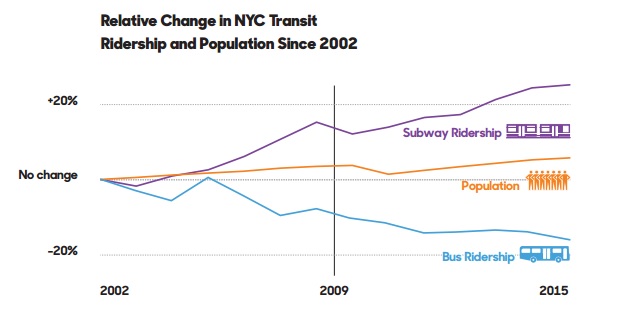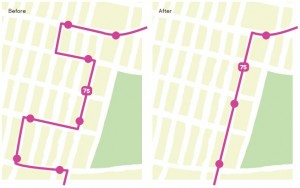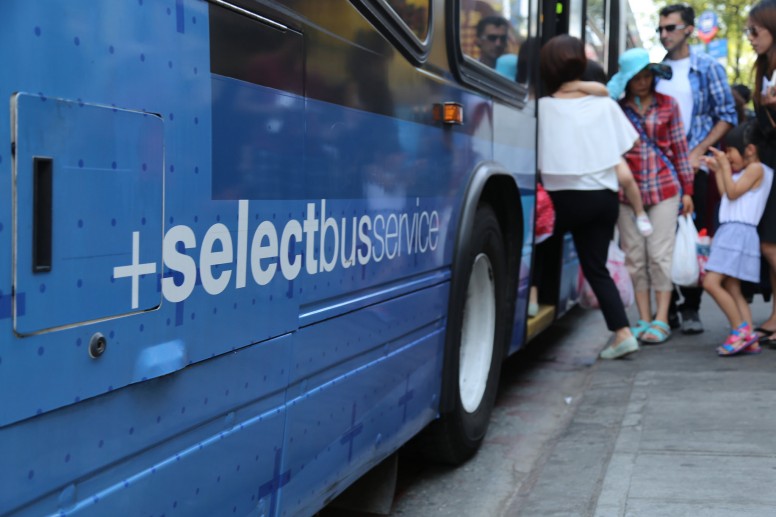Over the last decade, New York City’s bus ridership and reliability has plummeted, and still, 2.5 million New Yorkers ride the bus every weekday. The newly-formed NYC Bus Turnaround Coalition–comprised of TransitCenter, Riders Alliance, the Straphangers Campaign and TSTC–released a report outlining tested, cost-effective solutions to ensure quicker and more reliable bus service for New York’s millions of daily bus riders while attracting new ones as well.

and American Community Survey
Between 2002 and 2015, New York’s population grew by 5.7 percent, while subway ridership swelled 24.7 percent. During that time, bus ridership slipped by 16 percent. Average bus speeds have slowed to 7.4 mph, while buses in more congested areas, like Midtown Manhattan, Downtown Brooklyn and Jamaica Queens, average less than 4 mph.
The report, Turnaround: Fixing New York City’s Buses, looks to other cities for proven solutions to revitalizing bus networks. New York itself has previously demonstrated cost-effective tactics that improve bus service. On routes where the MTA implemented Select Bus Service, travel times improved between 13 to 23 percent while ridership rose between 10 to 31 percent.
We’ve been calling for capital improvements like dedicated bus lanes for years. But there are other tactics the MTA and the New York City Department of Transportation can implement to benefit millions of riders without requiring large infusions of capital funds or lengthy implementation.
Redesign bus routes for more frequent and efficient service by identifying how and where the network is failing, redesigning indirect routes, breaking up routes that are too long and rightsizing the distance between stops.

Transform how riders get on and off the bus by implementing tap-and-go on-board fare collection and all-door boarding. This must be a component of the MetroCard replacement project.
Adopt better methods to keep buses on schedule by ensuring that buses begin their routes on time, intervening early when buses get off track and instituting headway-based control for frequent buses.
Increase transparency about bus performance by reporting bus performance data in an accessible and easy-to-understand way and instituting a comprehensive open data policy.
These fixes are not only proven, but cost-effective and relatively easy to implement. But critical to better bus service for New Yorkers is coordination and commitment from state and city agencies, as well as elected leaders. New York’s 2.5 million daily bus riders deserve priority.
Brilliant. "Bunching is for bananas, not buses." (photo via @TransitCenter) pic.twitter.com/KRX3sMYQOc
— Tri-State Transportation Campaign (@Tri_State) July 20, 2016


[…] 4 Ways to Improve Bus Service Besides Dedicated Transit Lanes (MTR) […]
[…] The Urban Edge considers how Sun Belt cities have relied on annexation and sprawl to grow. And Mobilizing the Region presents low-cost ideas to reverse New York City’s bus ridership […]
Of course if they were to install escalator & elevators at the subways the elderly would abandon half the bus routes. The savings from the bus subsidies could then be applied to installing those long-wished for and desperately needed subway improvements.
[…] this summer, the NYC Bus Turnaround Coalition–of which TSTC is a member–released a report highlighting tested, cost-efficient solutions to secure quicker and more reliable bus service for […]